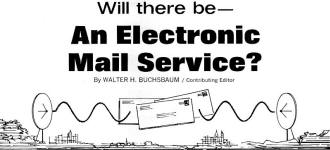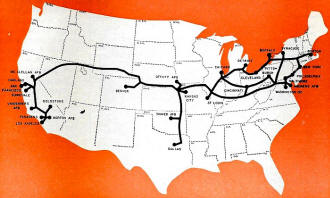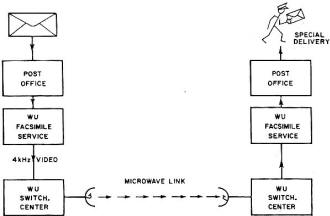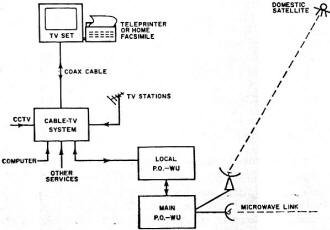Will There Be - An Electronic Mail Service?
|
|
Talk about prescience on the part of a writer! Electronics World magazine editor Walter Buchsbaum published this article in 1969 predicting the wide-scale adoption of electronic mail (e-mail) over a nationwide and even worldwide network. Interestingly, he questioned whether e-mail could help lighten the U.S. Post Office's load. Part of the scheme would include a joint effort by the USPS and Western Union whereby "Telegramletters" would be sent long distance via telegram and then printed and delivered by the Post Office to the final destination. It turns out to have practically crippled the USPS by usurping the vast majority of personal and business first-class service. A wideband microwave network and high speed landlines were envisioned in the form of Autodin (Automated Digital Network), which was replaced by ARPANET in the early 1980s, and finally became today's Internet (kudos to Al Gore - see video). Did you know the Pony Express, mentioned briefly in the article, only lasted about a year and a half because it was replaced by the telegraph service? Will There Be - An Electronic Mail Service? Will future mail be transmitted via microwave radio links? Can electronics bailout our postal system, which is now staggering under a deluge of mail? What about the proposal for an "informal merger" between Western Union and the Post Office? By Walter H. Buchsbaum / Contributing Editor Editor's Note: At last year's National Postal Forum, a proposal was made to have Western Union join forces with the Post Office to transmit "telegramletters" over its facilities with final delivery being made by a local letter carrier. Recently, it was disclosed that a limited trial of the plan for several months is in the works. If the plan doesn't develop too many bugs, it could go into limited public use early next year. Legislation would be required, however, prior to final use. A "telegramletter" would be faster than regular mail but slower than a telegram. Its cost would be below regular telegraph but above mail rates. From the days of the Pony Express until recent times our Post Office system has been considered a paragon of reliability, efficiency, and speed. During the past ten years this shining image has begun to tarnish and large deficits, combined with increasing rates and declining service, have made our once proud postal service the subject of many complaints. If we skip over the next 10 or 20 years and assume that these problems will be solved by electronics, we should be able to again depend on the postal service to "get the mail through" with high speed and reliability. Instead of the mailman making his rounds, we can envision an attachment to the home TV set which will spew out personal letters, bills from the department store, or more likely, the daily computer output showing your financial standing in the universal, over-all, everywhere, and everything credit-card service. To answer personal mail, we will simply slip the reply into our TV attachment and press the "Mail Transmit" button. To pay our bills we will put our credit card into the slot and punch the amount to be transferred into the keyboard on the TV attachment. Only parcel-post deliveries may still be made in person. How can this "electronic mail" service come about? Well, the beginnings of it are predicted in the not-yet-released report prepared by a 15-man interagency committee set up in 1967 by President Johnson to recommend new national communications policies. A brief paragraph released on December 8, 1968 recommended that Western Union be allowed to set up shop within U.S. Post Offices in various cities and some informal arrangement be provided to augment, complement, and merge some of these services. On the surface it is hard to see any great significance in this recommendation, but when we look into the operation of the Post Office and the services currently provided and planned by Western Union, it becomes apparent that a radical change in domestic communications services may result from such a marriage. Communications Explosion Fig. 1. Nationwide microwave system of Western Union is 7500 miles long and interconnects 267 stations. The main terminal points are indicated. Before World War II mail deliveries two or three times a day were common in major cities and the time it took for a letter to travel from Washington to New York was measured largely by the railroad schedules. Since 1939 the volume of mail has increased astronomically and in 1968 the U.S. Post Office handled 79.5 billion pieces of mail. Little has been done in the postal service to introduce automation on a large scale and, by and large, the general routing process and delivery of mail is still the same as it was 30 years ago. The recent addition of zip-coding and some automatic sorting machinery in major post offices has done little to expedite the mail. Western Union's basic telegram and telex service has also increased greatly. Between 1958 and 1967, the volume of messages has increased 789%. Not only are there more people in the country, but these people also communicate more, both by mail and telegram. The Post Office reports a 1.5% increase in mail volume between 1967 and 1968 and predicts a 7% increase in volume between 1968 and 1970. Although these percentages themselves do not appear dramatic, they indicate a spiraling trend which is a part of the so-called communications explosion. A number of critics of the Post Office have advocated that the entire business of handling the mail be turned over to a non-profit, government-sponsored corporation which would remove the Post Office from its ties to partisan politics and put it on a more business-like, "efficient," and, conceivably profitable or at least deficit-less basis. Could it be that the Presidential Commission had this type of thing in mind when it recommended the informal merger of postal and telegraph services? We have long been intrigued with the potential of Western Union in terms of domestic record communications since, by act of Congress, this company has the charter for all non-voice communications within the U.S. By evaluating the growth plans of Western Union, the advanced communications services now in use by the military and some large corporations, we will predict what the "informal merger" of Western Union with the U.S. Post Office could ultimately mean to domestic communications. Many of the possible services and their implications will be controversial and subject to Congressional politics, compromise, and modification, but we believe that the combination of Western Union's electronic message transmission and the physical message transmission provided by the Post Office will spell out an entirely new era in communications for all of us. Western Union's Wide-Band Service A basic principle of electronic communications depends on the fact that the bandwidth, in terms of frequency, required to transmit information is directly related to the amount of information it is possible to transmit within a given time. Until 15 years ago, the normal means of transmitting a telegram was the low-speed, 75-word-per-minute teletypewriter. The bandwidth required for this type of service was on the order of 150 Hz. An ordinary voice channel is 4-kHz wide and is generally used to transmit a frequency band of 3.8 kHz. By special techniques it is possible to transmit 4800 words-a-minute over this type of channel. TV transmission requires bandwidths of approximately 4 MHz although techniques are used to "bandwidth compress" video information into a 2.5-MHz channel. If you want to transmit more information faster you must increase channel bandwidth. Originally, Western Union transmitted only low-speed teletypewriter information and was therefore satisfied to lease long-distance lines at 4 kHz from the telephone company, or in some instances, provide its own wire network. With the increase in traffic, and with the need to provide high-speed data communications, Western Union embarked on an ambitious program of installing a nationwide wideband microwave system. At the present time this system is 7500 miles long and connects 267 stations, serving the major population centers and defense installations coast to coast. Fig. 1 shows the microwave network as it is currently installed. Initially equipped to provide 600 voice channels, or a bandwidth of approximately 2.4 MHz, the total capacity of the system is approximately 28 MHz. The wide-band microwave system consists of point-to-point microwave communications with towers and repeaters stationed all over the country. Services within any given city make use of available Western Union cables as well as the leased facilities of the local telephone company. How many private letters do you send and receive each month? Each year? The average U.S. citizen receives 407 pieces of mail annually. Clearly the vast bulk of this mail is not private correspondence. In fact, the Post Office has shown that most of the mail, and the vast physical bulk of the mail, consists of advertising matter, magazines, bills, statements, and corporate communications of various types. The bulk of this mail is further increased by the frequent addition of postage-free return envelopes, reader's reply cards, etc. Thus most of the mail carried by the Post Office contains printed rather than handwritten information. And much of this information is duplicated, that is, the same information is sent to many addressees. The Post Office and the Paper Glut The postal system's major problems fall into three areas: sorting the mail, transporting it between post offices, and delivering it to the individual addressee. Excluding parcel post, mail can be broadly divided into hand-addressed and machine-addressed envelopes of varying size. The problem of sorting hand-written mail automatically is difficult to solve and requires machines not currently available. Machine-addressed mail can be sorted by optical-scanning readers coupled to computers. Some test installations are underway and if such systems could be installed in all major post offices, this would greatly reduce the over-all sorting problem. The problem of transporting mail between cities remains a major cost item. Some publications, particularly some nationally distributed magazines, have provided a partial solution to the problem by shipping their press plates and having the magazines printed in or near large population centers. In a few instances national magazines publish special Eastern, Midwestern, or Western editions. But most of the mail still has to be transported by train, truck, or airplane between major cities. The most vexing problem facing the Post Office is delivery to the ultimate addressee. The individual mail carrier, bent under the ever increasing weight of his leather bag, is still the only available means of getting the mail delivered. Keep these problems in mind while we consider how information gets distributed in an advanced military communications system, such as the Autodin system described below. Lessons Learned in the Autodin System Autodin (Automatic Digital Network) provides only record traffic, that is, only messages in the form of teletypewriter printing, punched paper tape, or IBM cards. Controlled by a number of automatic, computer-controlled switching centers, the Autodin network makes use of all sorts of communications links, from simple telegraph wire to microwave, troposcatter radio, and in the past few years, satellite communications. Because it serves the Department of Defense, various levels of security classifications are provided for different messages and for different channels. Similarly, a range of different priorities permits urgent messages to pass through faster than those of a routine nature. Probably the most unique and vital feature of the Autodin system is the so-called "store and forward" message. This involves a technique of transmitting a message from the sender to the addressee without making a direct connection between two distant points. An air base in Okinawa, for example, wants to know if a certain spare part is available at a depot in Oklahoma. At the time this message is sent out, all of the circuits between Honolulu and the Mainland may be busy or else the equipment at the Oklahoma depot may be tied up. The Autodin system in Honolulu accepts the message from Okinawa and tries to forward it directly to the next switching center in line. If it is not successful in routing it via the shortest way, it will try a number of alternate routes. If the computer receives the information that all routes are busy, it will store the message for a short time, usually a few minutes, and will try again to transmit it. Thus the message is automatically passed on from one switching center to the next and is received in Oklahoma as soon as lines to that center are free. The great advantage of this technique is that the operator in Okinawa does not need to hold his circuits open but simply transmits his message to Honolulu and then continues to use his equipment to transmit other messages. Each message has its own assigned priority. If a high-priority message is received at a busy switching center, all lower-level messages will be stored and the high-priority message will go through first. All this is accomplished within micro- or milliseconds by a complex computer-controlled switching system. If the air base in Okinawa needs a specific spare part but does not know in which depot it is available, a message can be sent to all depots. This is accomplished by sending a single message addressed to all depots. Computer-controlled switching centers will automatically route the messages to their destinations. When an address is changed, the computer is informed and forwards the message automatically. In addition to such messages as the location of spare parts, payroll information is sent from each installation to the paymaster's office half wav around the world. This information is usually contained on IBM cards. Again information in a whole deck of IBM cards can be sent automatically over the Autodin system to a remote station, again using message store and forward techniques and automatic routing to produce a duplicate set of cards at the paymaster's office. We have cited two typical uses of the Autodin system which are not subject to security classification and which are relatively routine, everyday type of communications services. In addition to these, a number of other, unique, services are available which are vital to the national defense and which permit high-speed record communications between locations all over the world. The key element of all this, however, and the element which is of the greatest value to the ultimate domestic communications of Western Union, is the use of computer-controlled automatic switching centers. Some of the features of the Autodin network have already been applied by Western Union. It is, for example, possible to send a "multigram" by Western Union. This is a single message transmitted to a number of different addresses. Thus a corporation may send out a new price schedule to its sales offices all over the country. A company may call in its outlying dealers for an urgent meeting by a single multi-gram message, or organizations may use it to alert their members. It is only necessary to give Western Union the text of the message and a list of the addressees. The Autodin network has a whole array of messages with a fixed content in which only dates, sizes, part numbers, or other detailed information vary. To transmit these, it is only necessary to send the message code number and the pertinent details. Similarly, Western Union has a series of prearranged messages, such as congratulations for all occasions, where only the name of the person need be inserted. Westem Union also provides various services connected with goods and services of affiliated organizations, such as flowers-by-wire, candy-by-wire, money orders, and gifts-by-wire. Western Union provides the information link while local stores provide some of the merchandise. A relatively new Western Union service is leased facilities for transmitting information on punched tape and IBM. cards between computer centers. Also growing in popularity is Info-fax which is a facsimile transmission system, operating over a 4-kHz telephone channel and capable of transmitting a standard-size letter in about 3.6 minutes. In this latter field Western Union may be outpaced by Xerox and others who offer reproduction systems which the user can connect directly to the telephone line. In any event, much of the capability of Autodin is already available, and the interconnecting links within the United States, at least, are provided by Western Union's wide-band microwave system . Results of the WU-P.O. Combination Aside from the convenience of having the WU office right in the post office, and the possible revenue from this to the Post Office, a nunber of new services could be made available almost at once. In many instances, telegrams are now phoned to the addressee with the copy sent later by mail. Some time can be saved if the WU office is part of the local post office. A more important advance would be the facsimile letter service illustrated in Fig. 2. At a special fee, possibly slightly more than present special delivery, a letter could be mailed, opened, and put on the WU facsimile service for instant transmission to the post office nearest to the addressee, sealed again, and delivered by the existing special delivery service. For long distances, now covered by airmail, a day or two may be saved. Combined with WU's multiple-address service, such a scheme might be very attractive to business organizations who want to send out price lists, catalogue-change pages, or other information to dispersed offices. While this service might cut into airmail revenues somewhat, it would reduce the sorting and mail handling problem immediately, since intermediate post office stops could be eliminated. In February of this year General Electric, in a special filing before the FCC, described its proposed "Telemail" service which could transmit a 600-word letter anywhere in the U.S. for 33 cents by 1975. Using a large domestic satellite system with ground stations connected to computer-controlled switching centers, a whole range of communications services was proposed. While G-E is not in the point-to-point communications business, its concept of MADS (Multiple Access Digital System) could tie into WU's network. Future Benefits Thus far we have only considered presently existing communications facilities, but two new services are due to emerge in the near future which will benefit any WU-P.O. combination. One of these is some kind of domestic satellite which will add many more channels to the wide-band capacity of WU's microwave system. While such satellites will be used for telephone, picture phone, TV, and various data services, they will also provide sufficient additional channels for record communications. The second, already emerging, service is cable-TV. There are many services which cable-TV provides the individual set owner, but its application to record or message communications deserves special consideration. RCA has already developed an inexpensive printer which, when connected to the TV set, decodes information transmitted during the vertical synchronizing period of a TV signal and then is able to print such information as stock-market reports, news, and advertisements. When a cable, rather than the individual antenna, brings TV into the home, this multiplexed approach is not necessary since a separate frequency can be used for the additional data service. In place of an alphanumeric printer, an inexpensive facsimile machine could be used and that would permit not only text but pictures to be printed. Xerox already offers a very compact device which can reproduce a facsimile from narrow-band (4-kHz) data. Now we can combine all of the communications features into a system of the future and, as shown in Fig. 3, we can see how the prophecy of "mailing a letter in your living room" can become a reality. The coaxial cable connecting our TV set with the local cable-TV system will actually connect us to many other local services, and, through the WU-P.O. combination, to all parts of the country and, eventually, the world. In all likelihood we will have the option of either a printer and keyboard or a facsimile machine in our home. Either will contain a slot for inserting our credit identification card so that, instead of buying stamps, we can charge the cost of sending letters. The same device will let us charge the cost of seeing special programs over pay-TV, get stock quotations, order groceries, or pay the monthly cable-TV bill. We will be able to get our mail wherever we happen to be, by simply notifying the computer-controlled switching center. Within a particular city we will only have to insert our identification card into the nearest terminal and push the "Reserve Request" button. Thus far we have thought mainly of private, individual communications, but it is easy to see how such a system will benefit every type of business and government activity. Sales orders, and their confirmation, will be handled rapidly. Medical prescriptions, important records of all sorts, and information in all of its forms will be automatically transmitted between any two terminals, and terminals will be located wherever a TV set or a telephone is installed. There are, of course, many problems associated with this dream of the future, and some of them might even turn out to be nightmares. Right now we are besieged by a flood of advertising mail. What if this flood now comes direct to us via the printer or facsimile machine? Of course, we can shut off the machine, but then we might miss some really important message. Could we persuade the system to send us only mail addressed in our private code? Would this lead to "private code mailing lists" for sale? How about servicing the equipment? Would WU or a local dealer be involved? Would the facsimile machine or printer be leased or owned? What about the legal problems? How about the profitability of such it system? Clearly many questions remain and much development work is needed, not only in the purely technical but also in the economic, legal, and political fields. •
Posted August 15, 2017 |
|




